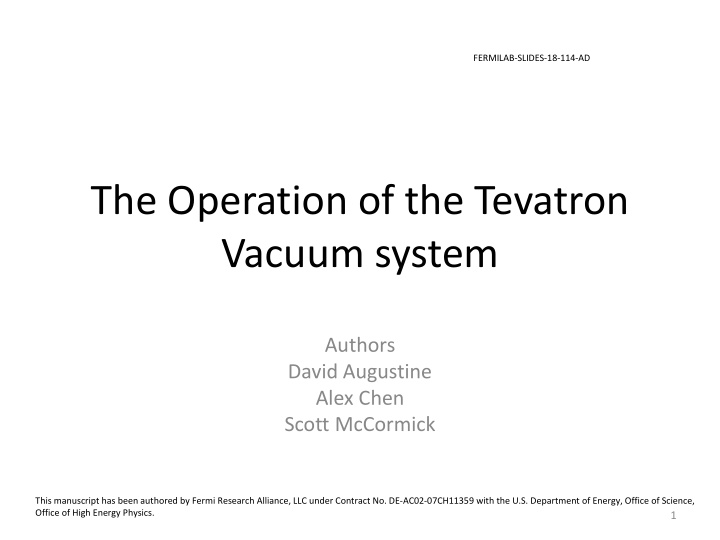



FERMILAB-SLIDES-18-114-AD The Operation of the Tevatron Vacuum system Authors David Augustine Alex Chen Scott McCormick This manuscript has been authored by Fermi Research Alliance, LLC under Contract No. DE-AC02-07CH11359 with the U.S. Department of Energy, Office of Science, Office of High Energy Physics. 1
Outline • Tevatron overview and some history • Vacuum upgrades • Cryogenic upgrades • Maintenance and records • Vacuum diagnostics • Failures • Lessons Learned 2
Fermilab Site Overview 3
The Tevatron contains • 24 Cryogenic loops. • 48 Insulating vacuum systems • 24 Cryogenic beam vacuum systems • 29 Major and minor warm straights • A cornucopia of gauges, valves, mechanical pumps, ion pumps, titanium sublimation pumps, and NEG 4
The Tevatron is installed under the original Main Ring Accelerator 5
Some history • Originally Tevatron operated in fixed target mode • Vacuum in warm insertion points was 10 -8 Torr • Insulating vacuum was 10 -4 to 10 -8 Torr • Cryogenic temperature was 4 to 4.5 K 6
Cryogenic and vacuum upgrades • Cryogenic system was upgraded – Magnets now operate colder which allows higher current on buss without quenching • Warm vacuum insertion points were upgraded – Better choice of materials – Improved cleaning technique – Vacuum baking • Reduced beam scattering due to poor vacuum 7
Tevatron Superconducting Dipole Insulation Vacuum Seal Beam Vacuum Pop-Up Nitrogen LHe, SC WIRE He Return CVI 8
Cryogenic Beam Vacuum System • No elastomers between the beam vacuum and atmosphere • Ion pumps various types, area dependent • Seals are all metal • Gauges are thermocouple, cold cathode, and ion • Vacuum pump out valves are all metal • Isolation valves are metal sealed on the outside but o-ring sealed on the gate 9
Warm Beam Vacuum • No elastomers between beam vacuum and atmosphere • System mostly electro-polished stainless steel or ceramic • Non metal objects are measured for out gas rate prior to installation • Many objects vacuum baked in situ • Electrostatic separator areas have all metal gate valves 10
Cryogenic Insulating Vacuum system • One turbo molecular and roughing pump every 450 feet • Vacuum breaks every 100 feet with isolation valves • EPDM (Ethylene Propylene) o-rings specified • Almost everything on the insulating vacuum system is sealed with o-rings 11
Maintenance records • Then – Originally all installations and repairs entered into paper log books – Information difficult to find • Now – All log books are web driven databases – Most accessible and editable outside of the Main Control Room – Electronic work list for work on operational equipment 12
Tevatron E-Log Maintenance entry 13
Electronic Work List 14
Vacuum remote readouts • Then – Limited remote control of vacuum hardware – Limited ability to data log past history of an individual device • Now – Lots of computing power to data log thousands of devices – Vacuum read out and control pages readily accessible 15
An example of a Tevatron Vacuum page, house A-2 ACNET driven 16
An Example: Vacuum and Cryo @E4
An Example of Diagnosis
Failures 19
Tevatron repair • Normal cryoloop – Seven days cold to cold with around the clock shifts • Low Beta cryoloop – 12 days cold to cold with around the clock shifts 20
Typical Repair Routine • During Warmup – Crews assigned – Insulating vacuum spoiled to assist warmup – Spares selected and tested – Equipment stationed in tunnel • When Warm – Insulating vacuum pumped out – Insulating vacuum leak checked first – Cryogenic circuits leak checked next – Sometimes damage obvious ie a 4000 amp ground fault 21
Ground Faulted magnet 22
View of beam tube 23
Equipment • Diffusion pump based leak detectors with upgraded electronics • Electronic signal from all leak detectors fed to one custom computer (1 to 16 channel chart recorder lab view based) • All signals can be analyzed at one time and compared to one another 24
Leak Detector 25
Chart Recorder 26
Chart of test 27
Lessons Learned O-rings Problem: original EPDM o-rings cleaned with acetone, causing o-ring to melt over time Solution: switched to EPDM colorized series o-rings for easy identification to choose correct cleaning solvents 28
The O-ring fix continued It takes many hours to disconnect, replace and o-ring We decided to vulcanize a new o- ring around the interface saving ~4 hours per interface 29
The end of a great run • Collider run to end FY 2011 • Performance of collider chain was stellar • The Tevatron will be warmed to room temp • Much of the vacuum infrastructure will be used in future neutrino projects 30
Acknowledgements • This presentation was made possible by the gracious assistance of: • Lucy Nobrega, Cryomodule Test Facility Vacuum Engineer • Linda Valerio, Accelerator NuMI Upgrade Installation Engineer 31
Recommend
More recommend